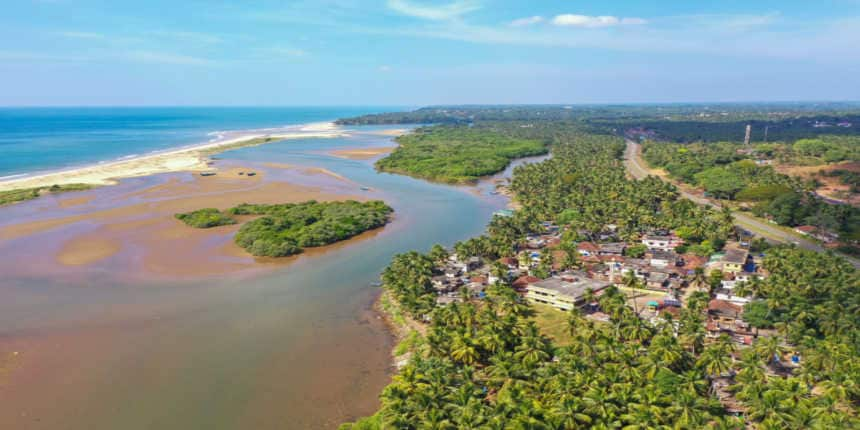CRZ Full Form
What is the full form of CRZ?
The Coastal Regulation Zone is the full name of CRZ. Under the Environment Protection Act of 1986, which is governed by the Ministry of Environment and Forests (MoEF), the Government of India issued a notification in 1991 to protect and preserve the ecology and ecosystem along the country's coastline. The coastal region up to 500 meters from the High Tide Line (HTL) and a stage of 100 meters along the banks of creeks, estuaries, backwaters, and rivers susceptible to tidal fluctuations are considered to be inside the Coastal Regulation Zone, according to the notification (CRZ).
- What is the full form of CRZ?
- Things That are Prohibited Inside The CRZ
- CRZ Zones Classification

Things That are Prohibited Inside The CRZ
Within the CRZ, the following activities have been declared illegal.
Establishing new industries and growing existing ones, excluding those immediately connected to the waterfront or in need of foreshore facilities.
The production, handling, or disposal of hazardous materials.
Establishing and growing fish processing facilities, including warehousing ( excluding hatchery and natural fish drying in permitted areas).
Installing and expanding equipment for dumping garbage and effluents into waterways.
Discharging of untreated wastewater and city waters from businesses, towns, and other populated areas.
The practice, if any, of dumping municipal garbage for landfilling or other purposes shall be phased out within a reasonable period of time not to exceed three years from the date of notification.
Ash or other trash disposals after the notice date.
Land reclamation, construction, or other activities that alter the normal flow of seawater with similar observations, excluding those necessary for maintaining or controlling coastal erosion, sandbar construction, or stormwater recharge.
Sand, rock, and other substrata mining, which is not permitted outside of CRZ areas
Groundwater harvesting or drawing is allowed within 200 meters of the HTL, but within 500 meters of the HTL, it must only be done manually through regular wells for drinking, horticulture, agriculture, and fishing.
Building projects in ecologically delicate locations
Any construction between LTL (Low Tide line) and HTL(High tide line) , with the exception of facilities for treating effluents and waste discharges, pipelines for oil, gas, and similar substances, and dressing or altering of sand dunes, hills, and other natural features, including landscape changes for aesthetic, recreational, and other similar purposes.
CRZ Zones Classification
Coastal Regulation Zones (CRZ) were initially announced by the Indian government. The coastal regions are divided into four categories, CRZ-1, CRZ-2, CRZ-3, and CRZ-4, according to the CRZ 2011 notification.
The guidelines of CRZ 2011 notification are:-
CRZ 1
Exceptions for brand-new buildings
Building highways and trans-harbor sea links between HTL and LTL, etc., without affecting the tidal flow.
Initiatives involving the Department of Atomic Energy.
Other authorizations given for interactions between HTL and LTL include:
Exploration and extraction of natural gas
Salt production
Desalination facilities
Facilities for non-hazardous cargo storage in the notified ports.
CRZ 2
Building permits are required for the dangerous line's landward portion.
Desalination plans, among other things, are permitted for activities including HTL and LTL.
Only according to the rules outlined in the notification are certain types of construction allowed.
CRZ 3
Exceptions in new construction.
Building highways and trans-harbor sea links between HTL and LTL, etc., without affecting tidal flow.
undertakings including the Department of Atomic Energy, petroleum products, salt production, and other public facility projects.
construction of housing for nearby communities in various places.
CRZ4
The traditional fishing practiced by nearby communities is unrestricted.
These places may not be used for the discharge or dumping of solid waste or untreated sewage.
Frequently Asked Questions (FAQs)
Protecting ecologically delicate areas is vital, such as coral reefs, which serve as a barrier against storms and tsunamis. The lifestyles of coastal people, including fishing villages, can be improved by maintaining the safety of the coastal zones.
HTL is the area of land that the highest water line during the spring tides extends to. LTL is referred to as the point on the land where the lowest water line during the spring tides reaches.
In all zones, sewage and waste drainage was ruled unlawful by the CRZ 2011 notification, which also set a deadline for defaulters to stop these operations completely. Industries that did not phase out by the specified date were deemed to have broken the law.
The coastline lengths of the Andaman and Nicobar Islands, Lakshadweep, and small islands are included in CRZ 4.
However, the Hazard Line has been cut off from the CRZ regulatory framework and is now solely to be utilized as a tool for disaster management and planning of mitigation and adaptation actions.